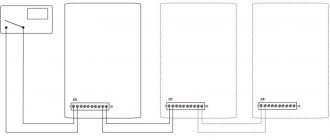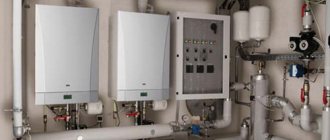The main purpose of gas meters with a thermal corrector is to increase the accuracy of natural gas metering in case of significant temperature deviations from the GOST standard, on the basis of which the accounting mechanisms are adjusted (+20°C).
The lower the ambient temperature, the higher the gas density. At -20°C the error exceeds 18% , and in combination with high atmospheric pressure, reaches 20% . At high values (+40°C the opposite effect is observed due to a decrease in gas flow density).
What you need to know before installation
The Law “On Energy Saving...” of 2009 was amended, and the mandatory installation of HS was abolished. They left it for those who use gas for heating their homes, while spending more than two cubic meters per hour.
The rules for installing a gas meter in a private house require submitting an application to the gas supply organization, with a passport, a document confirming ownership. If there is already a GS, then those too. documentation for it.
But it is better to first call the gas service about the necessary documents.
The owner-customer decides the location of the meter - external or internal. And taking into account his opinion and mandatory conditions, visiting specialists from the gas service determine the location for the gas station. It is better to contact specialists who will then provide service. Since the law allows you to simultaneously execute and accept, then you need to take advantage of it.
According to the contract, the user is obliged to inform the gas company about detected malfunctions: the gas casing, seals, doubts about proper operation. Gas workers are given a month to troubleshoot problems and six months for the next check of the gas system.
Checking a gas meter in a private house is completely different. For each type of meter, the manufacturer establishes in the HS passport the frequency of verification, for which the meter is dismantled by specialists and then delivered by the user to metrology.
You need to know the date of manufacture. The deadline for the next verification is calculated from this. It is indicated in the passport. You should not take stale HS.
When purchasing a meter, you need to check with the installation specialists: what modification is needed - right- or left-handed. On most devices, the direction of flow (right or left) is indicated by an arrow.
Procedure and installation features
Installation of a gas meter in a private house includes:
- selection and purchase of HS;
- paid order of technical specifications;
- paid order of the Project for installation;
- paid installation work.
The requirements of SNiP 42-01-2002 and SP 42-101-2003 are mandatory. For HS indoors:
- the selected location must provide installation, maintenance and repair;
- by distance: no lower than one and a half meters above the floor, 3-5 centimeters from the wall and no closer than a meter from the consuming device;
- placement in an adjacent room with a door is possible;
- the room is well ventilated.
For outdoor use: provide protection from sun and rain. The additional costs of constructing a box for the heating system or at least a canopy, laying pipes and ensuring a milder temperature regime are fully compensated by the possibility of purchasing cheap and reliable membrane meters, which are quite noisy for a living space, as well as saving space in the house.
Next, the operation of the gas generator is checked by engineers for stability, interference with gas flow, and gas leakage. And the GS readings are recorded.
A Certificate of Completion of Work is drawn up, one copy of which is received by the customer, along with a receipt for payment made by him.
And the last step before concluding a contract between the supplier and the customer is sealing. The gas supplier’s specialist checks the compliance of the established gas system with the project, puts a seal and also draws up a report.
Lifetime
The service life of a gas meter in a private home depends on the type of model, indicated in the passport. Range of possible terms: 10-25 years.
Rules for replacement and transfer
A gas meter in a private home can be replaced due to a faulty gas meter or at the end of its service life. And also during the next verification, if the owner wishes. Replacement is made at his expense. Except in cases where the warranty period has not expired. If the GS is cheap, then it is better to replace it during verification or when transferring it.
To replace the HS, it is not necessary to contact Gorgaz; it is often more convenient and cheaper to work with a third-party company that is accredited for such work. Then everything is similar with the transfer.
There are many reasons for the transfer of gas, for example, the transfer of a gas meter in a private house due to kitchen renovation. Or if the rules for placing the GS are violated.
The first step is to call the gas service and find out where to get the application form. If the changes affect the entire gas supply of the house, then the participation of gas engineers and coordination with them will be required. You will need the same documents as when installing the HS, plus the latest verification report. They may require confirmation of payments for gas office services.
An estimate for the transfer of the HS is drawn up, a date for work is set, and payment is made. After the transfer, the joints are checked with soap foam. The Certificate of Completion of Work is signed. And a Statement Commissioning Certificate is drawn up.
To seal the meter, you need to fill out an application at the customer service department. The period for installing the seal is 5 days.
Repair or replacement?
In some situations, replacing equipment may be more profitable than carrying out verification and repair work. If the device breaks down, you will have to pay for the dismantling work, examination and, if it is impossible to restore correct operation, a new flow meter and its installation.
Moreover, all the time spent on these manipulations, gas fees will be calculated based on regional standards.
Therefore, many users who suspect a major breakdown of the device prefer to immediately install a new meter. The old one is either disposed of or, after successful repair, stored as a spare until the end of its service life.
Criteria for choosing a device for a private home
Already the marking of devices indicates their main parameters. The number indicates the number of cubes that can be measured (throughput). The letter T indicates that the HS is temperature-controlled, that is, it can be installed outdoors. The type of device determines the period of scheduled verification and its functionality.
And of course, the price.
Gas meter for a private home
The best gas meter for a private home is determined by the combination of all these parameters, the size of the house, that is, the required amount of gas, and the financial capabilities of the owners. Usually the best counters in each specific type are identified.
Is a gas meter required in an apartment?
According to paragraph 1 of Article 13 of Federal Law No. 261 “On energy saving and increasing energy efficiency and on amendments to certain legislative acts of the Russian Federation,” adopted on November 23, 2009, all devices that consume energy resources must be equipped with meters.
But there are a number of exceptions that allow you not to install measuring instruments without violating the law. If gas equipment is located in a building in emergency condition, subject to demolition or reconstruction, then it is not necessary to install a meter.
Also, a meter is not required if the volume of gas consumption does not exceed two cubic meters per hour. In simple terms, if only a gas stove is installed in the apartment, then installing a meter is not mandatory.
Types of gas meters
Depending on the engineering solution for gas metering, the following types of gas systems are distinguished:
- membrane;
- rotary (rotary);
- turbine;
- vortex.
And depending on how they are controlled, they are also distinguished as electronic and smart.
In rotary meters, two rotors, similar to figure eights, rotate inside. They create a pressure difference and move a large amount of gas, so they are more often used in boiler rooms and small enterprises.
In turbine hydroelectric generators, the gas flow rotates the turbine, the speed of which increases in linear dependence on the increase in flow volume.
Low noise, no high gas purification required, reliability and ease of maintenance. But a uniform flow of the mixture is required.
Vortex HSs operate on the principle of calculating the frequency of pressure oscillations that are formed when a gas mixture swirls into vortices. The advantage is that there are no moving parts. But the outlet pressure drops significantly, and the error sharply increases with a contaminated gas flow.
Membrane models
In several chambers, the gas flow is divided by means of a moving membrane, and after each cycle the gas fractions are summed up.
Straight sections before and after the horizontal line are not required. There is no need for high purification of the gas mixture.
Most popular for private homes. And there are a number of good reasons for this: they are simple, cheap, accurate and durable (30 years). A large interval between verifications is 10 years.
And the existing two disadvantages - noisy operation and large sizes - are eliminated by placing them outside the house. But they are sensitive to low temperatures (the error jumps), so temperature compensation is required.
Prices range from one and a half to three thousand rubles. Meters with higher capacity cost more. The cost is even more influenced by the presence of a temperature compensation mechanism (with the letter T). So VK G4 costs 2200 rubles, and VK G4T costs 3400 rubles.
Electronic
For new private houses, electronic gas meters are more often chosen, which is associated with the income level of their owners - these meters are much more expensive than membrane meters: from 4 to 10 thousand rubles. Their small size and noiselessness allow them to be placed inside the house. This is also facilitated by the pleasing design.
Highly accurate, not afraid of temperature changes.
The information on the display is more clear compared to membrane ones. Information can be transferred to a computer (when installing an additional device).
And very important - ease of installation and operation. No welding required.
Verification once every 12 years.
Smart meters
But the positions of electronic HS are also under attack. Young owners are closer to everything modern and smart. Including meters, which become elements of a smart home. Install this one and forget about it. Then he handles it himself - transmits the readings to gadgets, reports on interruptions in work. For it to work, you need an application on a gadget (usually several) and Wi-Fi. The presence of the latter imposes restrictions on the use of smart meters.
With a modem, the HS will be able to work away from home, for example, in a boiler room. It can also be installed at the gas pipe inlet.
The price of smart meters is about 10 thousand rubles.
Information to note: Hood for a gas boiler in a private house
Quality control
Any work must be carried out taking into account all safety rules: • The distance of the meter to gas equipment must be more than one meter; • The standard height for fastening is 160 cm. Each change must be confirmed by the meter passport; • Heating devices should not be located within a range of two meters from the unit; • The meter must be easily accessible for working with it; • The distance between the installed preparation and the wall must exceed 5 cm;
Having learned in advance all the nuances and rules of installation, you will be able to control the work of the specialist, which will save you from problems in the future and unwanted additional costs. After installing a new device, you should carefully monitor the indicators for several days, and if the readings change significantly, call the service and ask to carry out the repair work again.
Rating of models for the street
Outdoor gas meters for a private home are preferable in houses with high gas consumption - due to their large size. And if they are membrane-based, they are noisy. They are specially designed to make a gas meter on the street in a private home look visually attractive.
SGK-G4 Signal
The best street model, membrane. PS from 4 to 6 m3/h. The error is from one and a half to three percent.
Particular advantages (and for some, disadvantages) include the inability to stop the GS and rewind it.
Service life is 20 years, verification – once every 10 years.
Small dimensions and noiselessness allow installation inside the house.
Price – 1700-2600 rub. Quite acceptable.
Some consider modest functionality to be a disadvantage. And a slight decrease in outlet pressure.
Vector G6
Membrane HS in two versions: with LCD display or mechanical calculating device. PS – up to 10m3/h.
Resource – up to 25 years, with verifications every 10 years.
The cost is 6,400 rubles, which is due to the large bandwidth (bandwidth) and LCD display.
Highly accurate and silent.
Possibility of connecting to gadgets, archiving.
No stopping.
Grand-6 TK
The Grand-6 TK version is considered the best in the electronic GS category. Although it is significantly more expensive than the model in 2nd place: 5100 rubles. against 2400.
Very good at extreme temperatures.
Batteries and high price can be considered disadvantages.
VK-G4T
Russian-German membrane (diaphragm) model with a bimetallic temperature compensator. Modifications - with flows to the right and left.
PS from 4 to 6 m3/h.
Very sensitive and accurate GS. Insensitive to flow contamination. Almost silent.
Service life – 24 years. Verifications - every ten years.
Price: 4000-4500 rub.
Initially, it was more designed for public utilities.
Gas device NPM-G4
Membrane meter with typical characteristics (see previous HS)
It stands out for its excellent efficiency/cost ratio, stability and compactness.
Price 2500 rub.
Requirements and reasons for change
Since 2013, when Resolution No. 824, enshrined by the government on September 19, came into force. This law made adjustments to the rules for conducting public services. For the most part, this affected the requirements and algorithm for replacing devices for monitoring gas consumption in an apartment or enterprise. Referring to the law, it is required to dismantle the old meter in the following cases:
• End of the operating period, which is specified in the documents for the device; • After negative conclusions during a specialist check.
The latter includes:
physical and mechanical damage, documented errors in readings, displacement of seals, inability to read and remove meter readings. If the seals are damaged, the owner may be fined, so their integrity should be checked periodically.
History of the issue of thermal correction
With the rapid development of industry in the USSR, the question arose about the accuracy of units of physical quantities and the unification of measures, weights, calibers, etc. Then, as the base of standards accumulated, the turn came to the area of gas consumption metering.
Development of standards
So, back in 1963, GOST 2939-63 “Gases. Conditions for determining the volume" - LINK, which finally determined the specific values of temperature, gas pressure and humidity for the accurate calculation of the gas volume consumed, called standard. This one-page document is valid and is still in use today.
But progress does not stand still, and requirements have already appeared for measurement methods that are used to recalculate to standard conditions, requirements for measurement conditions, and these are: the exact temperature in the flow, gas pressure in the flow, gas compressibility coefficient, and other parameters.
In connection with the new requirements, GOST R 8.741, as amended in 2021, was developed, which normalizes the requirements for measurement methods.
Phew, we sorted out the standards. The last of them describes the process of bringing it to standard conditions; those who are curious can click on the link and take a look. There are formulas for manual recalculation of the working volume of gas - this is the volume accumulated under natural conditions to the reduced volume, that is, to the one from the accumulated working volume that is adjusted to standard values using real values of temperature and gas pressure. This recalculation process is called “reducing the measured volume value to standard conditions.” In order to recalculate the actual value of the gas temperature in the flow to a standard value, a thermal corrector is used.
So we got to these same devices.
Physics of the thermal correction process
Gas has certain physical properties. Volumetric thermal expansion/compression of gas is known from school physics courses.
Accordingly, if it’s hot outside, then more gas will pass through your meter, and a meter without a thermal corrector will count excess, which in fact was not there. At negative temperatures, the picture certainly looks much more profitable for the consumer, but almost all gas distribution stations are equipped with a heating function, i.e. The gas that the gas distribution company measures at home is warmer. And you might think, so what’s wrong with this, but not a single company wants to suffer losses, hence the constant increase in tariffs, which affects the consumer’s wallet.
Suppose we are for honesty, and we want that in any conditions at any temperature, both the end consumer and the supplier receive correct readings, not overestimated or underestimated, but as if the gas temperature is always equal to 20 ° C.
Expand and contract
In order for all this to happen automatically and the correction to 20°C to be as accurate as possible, gas meters must have an additional device that measures the real gas temperature.
What documents are needed
Before installing a meter, you need to conclude an agreement with the city gas service.
Documents for installing a gas meter:
- Passport of the owner of the premises;
- Certificate of ownership;
- Passport for the meter;
- Passports for gas appliances;
- Plan of the gasified premises.
After collecting the documents, you need to contact Gorgaz, fill out an application for concluding an agreement there and hand it over to the employee along with all the documents. Your application will be registered and you will be contacted within 5 working days to confirm the date of the work.











